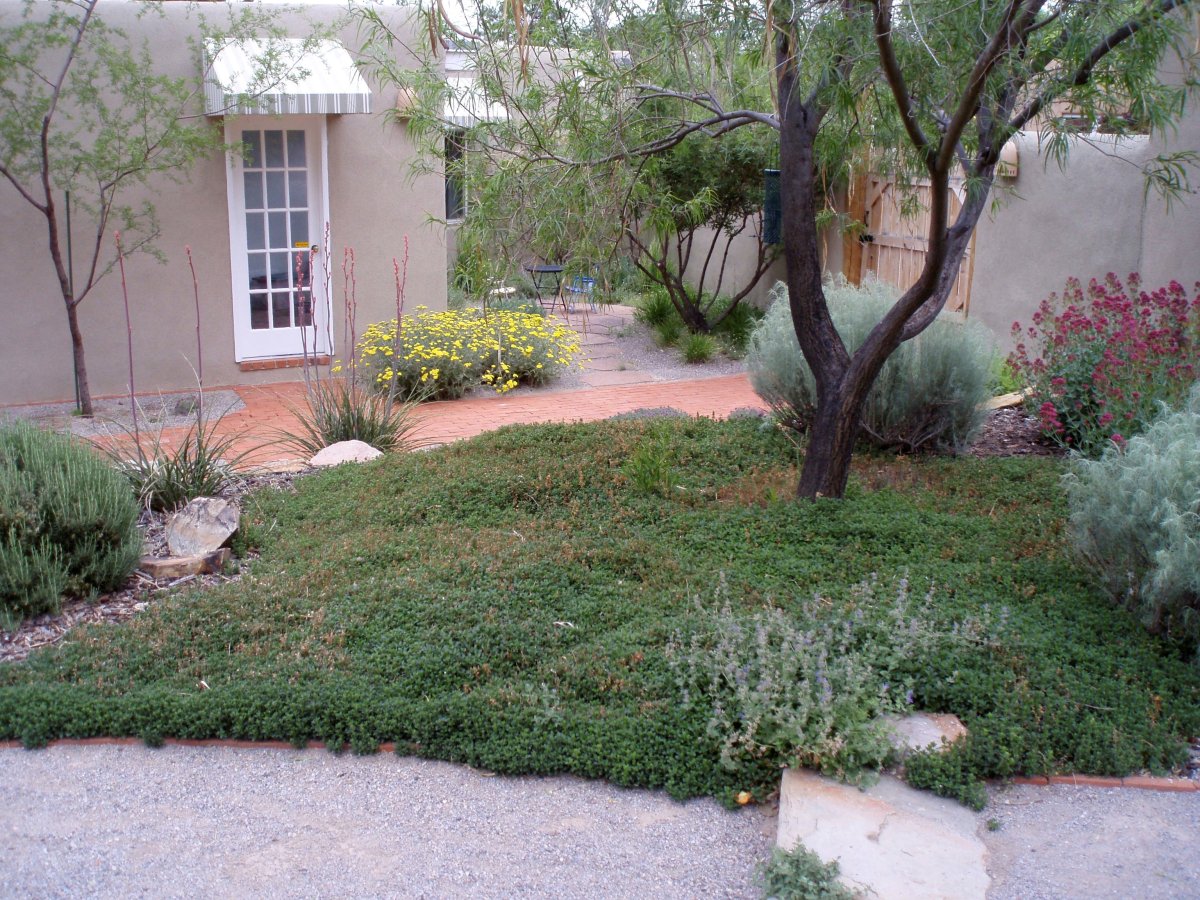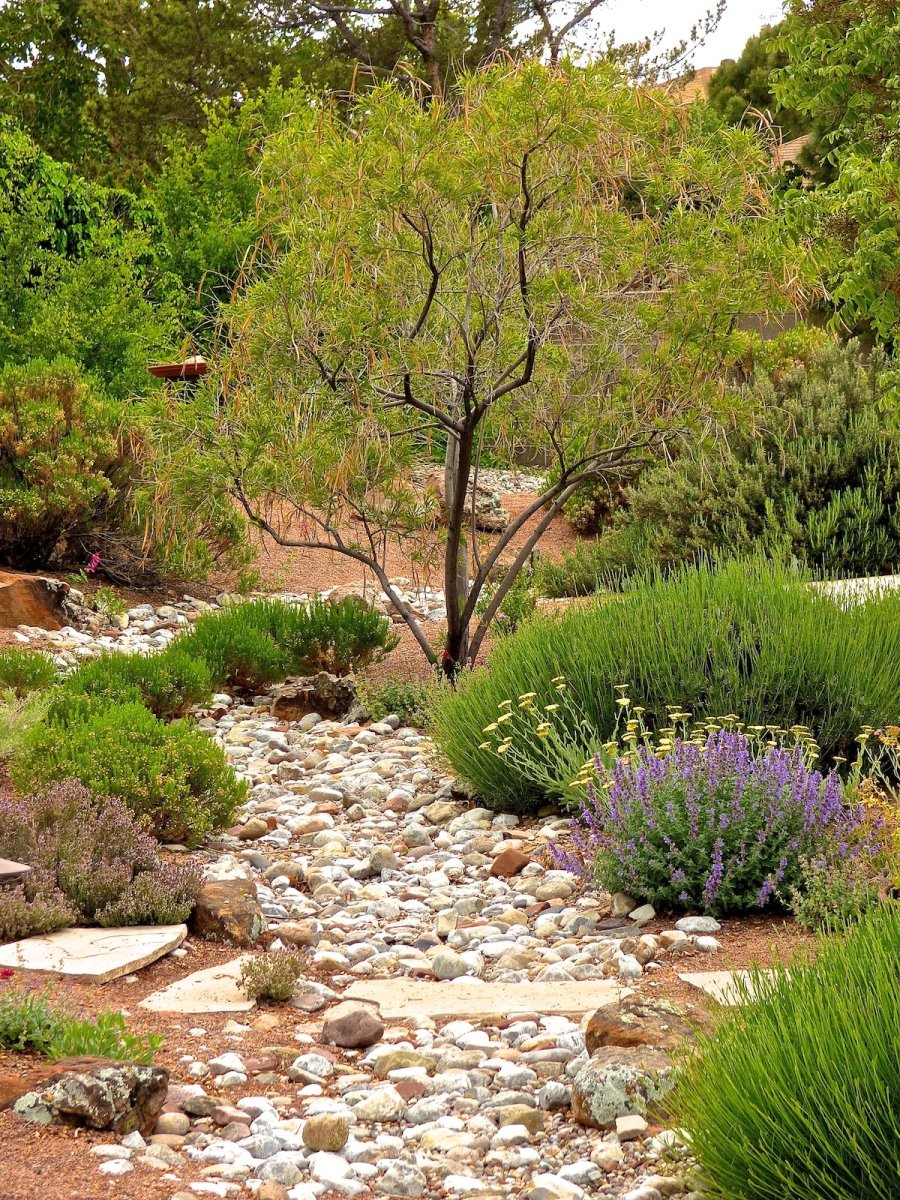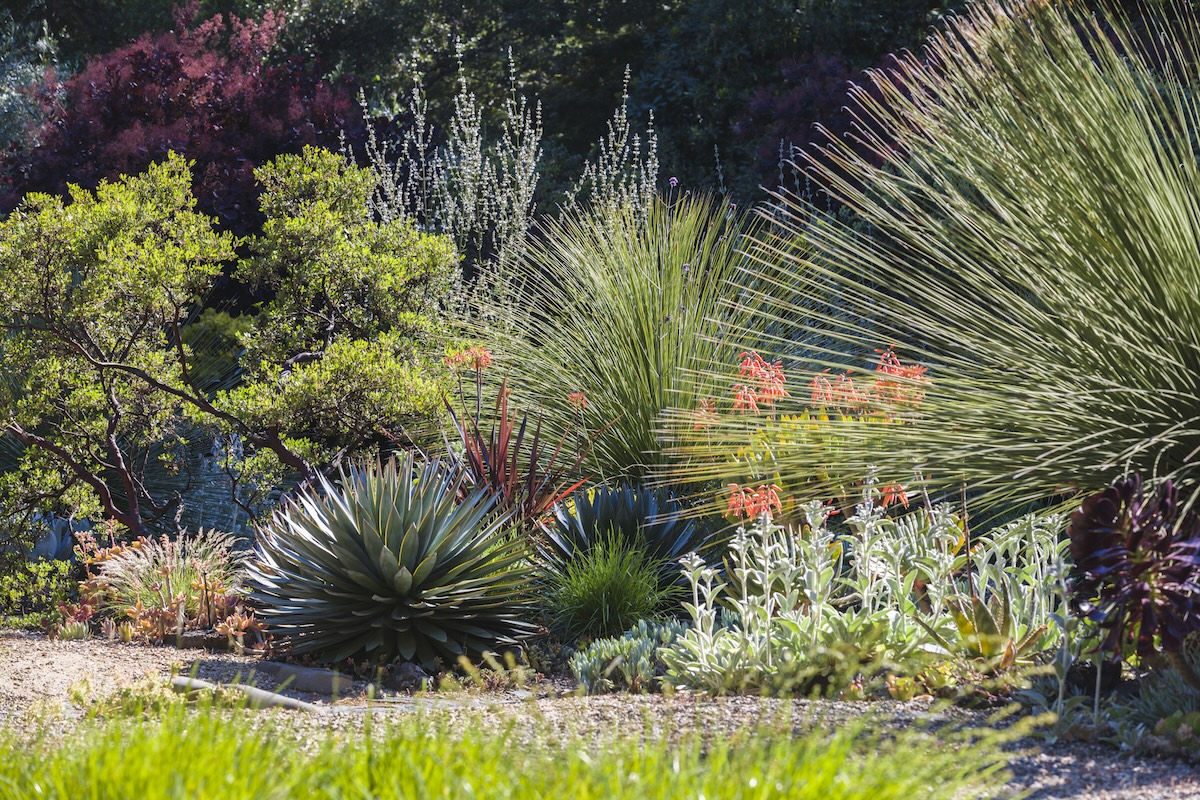

We may earn revenue from the products available on this page and participate in affiliate programs. Learn More ›
When people consider what xeriscape landscaping is, they might picture all-gravel yards and little to no color. But the truth is far from that. In fact, spreading gravel and ripping out all plants but one tree is not good practice, no matter where you live. For example, leaving that one tree surrounded by gravel can eventually kill it and is not among the best xeriscape ideas or the best way to save water.
In fact, although water conservation is at the heart of xeriscaping, avoid “doing it at the expense of the landscape,” says Judith Phillips, garden book author and owner of Judith Phillips’ Design Oasis in Albuquerque, New Mexico. It’s more than possible to save water without sacrificing plants and beauty. “These days more than ever, we need plants; they keep things cooler,” says Phillips. The following xeriscape design ideas support more than saving water. They offer resilience, plant diversity, colorful landscapes, and support of pollinators and wildlife.
1. Know where you live before buying plants.
Both Phillips and landscape designer Hunter Ten Broeck of WaterWise Landscapes in Albuquerque, New Mexico, emphasize the importance of regional gardening. Beyond generally selecting native plants vs. exotic ones, look for those most adapted to your area. Research your soil type, average rainfall, and plants that grow best in your community. Ten Broeck suggests you seek a local expert. “I also push people to find as much locally sourced plant material as possible,” he says.
The benefits of selecting local native plants can include less water use, the plants’ contribution to pollinators and wildlife, and a likelihood of less maintenance for homeowners. When you select a plant native to where you live, it’s more resilient, which decreases its chance of dying in that first year. This saves the money that would be needed to purchase a replacement plant and the water required to establish another new plant.
2. Ditch some gravel for mulch or ground cover.
The tendency to replace grass with landscape fabric and gravel might seem like it makes for a low-maintenance xeriscape front yard, but it actually has led to hotter, less attractive yards and even the demise of plant life. In fact, Phillips cites the practice as part of the reason that Albuquerque began to rank among the top cities for urban tree loss beginning in the early 2000s. Removing the turf and not replacing that water or cooling effect it offered will likely lead to the tree’s eventual death.
As Phillips explains, pores that transpire moisture in trees are on the leaves’ underside. “When you spread gravel under trees, it heats up and increases the moisture use of the tree but doesn’t provide the tree with any moisture,” says Phillips. Instead of gravel, she and Ten Broeck both use shredded wood mulch, pecan shells, compost, or xeriscape ground cover under the tree’s canopy to retain moisture and cool the ground. The same concept applies to most shrubs and flowers, except for the biggest heat and drought lovers.

3. Include shade in your landscape.
According to Ten Broeck, the Southwest has been hit particularly hard with rising temperatures from climate change. “Shade is becoming more important,” he says. The cooling effects of shade make people more comfortable and can help protect some plants from hot afternoon sun. “A tree is going to cool the space under it by at least 10 degrees on a hot day and it makes the air slightly more humid,” adds Phillips.
Shade from trees also helps cool homes; Ten Broeck says that having trees on the Southwest side of a home or landscape is especially important. And if you live in an area that is forested or want ground cover under your trees, select plants that thrive in shade. “Here, I plant creeping germander and dwarf plumbago, reliable ground covers in the shade, for our projects,” says Ten Broeck. Both are also drought-tolerant.
4. Capture or redirect rainwater.
Catching water in a rain barrel or cistern to use for irrigating plants is often part of xeriscape garden plans and an efficient way to save water in your landscape, but it’s not the only idea. You also can direct or redirect water so that it runs to the ground around your tree when it rains. Creating a dry river bed, for example, is an excellent use for rocks and gravel, which can slow the water’s flow.
He adds that these projects also can help in areas that receive more and heavier rain. “You have too much water, so how can you direct it away from places that might flood?” Redirect that extra water to plants that can use it without suffering from wet soil. A page from The Ecological Landscape Alliance lists dry river examples.
5. Maintain trees sustainably.
If you can’t direct rainwater to your tree, try helping the ground retain moisture and provide the roots with a sustainable irrigation option. Replacing gravel and landscape fabric with mulch is a start, but where you place drip emitters also matters. A common mistake people make when they plant a tree is to place emitters near the base of the tree. “Then everything else around it is dry and the tree can’t root out,” says Phillips. She says a larger shade tree might root out 80 feet or more from the trunk as it matures.
Phillips says you don’t have to cover all the ground that far out, but you can create pockets of ground cover further from the tree and add a drip emitter for each plant. “The roots will radiate out to find water and the purpose of the other plants is to share water with the tree,” she says. Ten Broeck also places tubing with emitters every 12 inches around the tree in a spiral to water the tree as it grows and plants ground covers there.

6. Choose a diverse set of plants.
When Ten Broeck designs a xeriscape garden, he makes plant selections with timing in mind “so that there is something blooming through the whole year.” This strategy improves the beauty of your landscape by offering color from flowers, foliage, or ornamental grasses in all seasons and helps create a wildlife habitat in your own yard; it can help retain the diversity of pollinators, for example.
There’s another plus to diversity in plantings: Having too much of one species can attract insects and diseases, even causing killback of the plants you’ve carefully watered and maintained. Phillips also supports plant diversity. “To me, part of the reason to limit lawns is to increase plant diversity with native grasses, wildflowers, and native shrubs that also provide habitat value. Everything’s related,” she says.
7. Aim to create a wildlife habitat.
As you plant multiple species in your gardens, you also add to the landscape’s appeal to various creatures that help to make a healthy ecosystem. According to Phillips, “grass is a waste of water; it’s a green desert in terms of the habitat value it has.” Native flora, on the other hand, evolved in concert with the fauna species that depend on the plants, and vice versa.
Designing your yard so it provides wildlife habitat can be beautiful and sustainable. “It’s about more than just a water-conservative landscape,” says Philllips. “It’s about getting the most value for the water you’re putting on the landscape.” Aiming for local or national habitat certification can make your landscape beautiful, save water, and add interest with pollinator activity. Ten Broeck says “the whole idea is to create a web of habitat” as we all do a small part.
8. Zone plants by water and maintenance needs.
Having plant diversity in the landscape should not complicate maintenance, and especially watering. A long principle of xeriscaping has been to place plants with higher water needs in an oasis zone close to your home, and then transition outward with waterwise plants in the next zone and only xeric plants in the outer area.
But less important than placement of these zones is grouping together plants with like needs. “To zone plants by water is important; I also zone them for maintenance,” says Ten Broeck. “Place fewer bigger plants that need less maintenance further away,” he adds. Still, if you are planning a dry river bed or a rain garden, however, you also can place plants with higher water needs where they deposit rainwater or where it naturally pools. But avoid using the same drip for a xeric plant and a nonnative, for example.

9. Improve your soil.
Improving soil slowly over time also makes the soil more permeable, which improves air and water penetration, so remember that soil health and water savings work together. Adding some organic matter to the planting hole does not help the plant once its roots reach the hole’s boundaries, where the soil lacks nutrients and good drainage.
A reason that Phillips opts for shredded wood instead of wood bark for mulch design ideas is the shredded wood’s ability to break down on the soil surface. “As it does, it feeds mycorrhizae that actually then attach to and have a symbiotic relationship with tree roots,” she says. This soil activity assists the roots’ ability to absorb water and minerals from the soil, which improves plant health and conserves water. Pecan shell mulch, compost, and cover crops also improve soil, but it can take years to see results. Healthy soil containing organic matter also helps cool plant roots and retain moisture.
10. Limit use of landscape fabrics.
Adding organic mulches on top of landscape fabrics stops the natural breakdown of organic matter, so it might deter some weeds from growing, but does not stop them altogether or do anything to improve the health of the soil below. Impermeable black plastic used to appear in many xeriscape front yards, but it is the worst cover. Even woven fabrics have drawbacks. “The rain doesn’t penetrate through it until it’s saturated—and then slowly,” says Phillips.
Another drawback to fabric is the ability of ground covers or flowers to spread. The fabric can block reseeding of flowers and make it more difficult for plants that spread by runners to fill your garden as you would like. Still, some runners and weeds will seek cracks and edges of the fabric. The best use of fabric is in walking paths to cut down on weeds, and most paths are covered with crusher fine or similar materials that won’t break down like shredded wood.
11. Replace turfgrass with an ornamental grass meadow.
When seeking turfgrass alternatives as backyard xeriscape ideas, choosing native grasses for small spots of lawn can keep water use in check and give pets and kids a play space. Still, all grass needs some spray irrigation at times. Sprinklers and spraying are the least efficient ways to water, especially compared to drip irrigation or soaker hoses. Meadows are popular landscape features, but Ten Broeck recently replaced a native grass and wildflower area of his yard with ornamental grasses. “You can make a ‘meadow look’ with ornamental grasses as mass plantings with drip irrigation,” he says.

12. Opt for permeable hardscaping.
Like a city, your yard might be full of hard surfaces that water can’t penetrate; instead, it runs off into storm drains or pools in spots on or around your property. “Some parts of the country are dealing with too much water,” says Phillips. Today’s technology includes permeable asphalt, concrete, and various types of pavers. They allow water and snow to seep through the soil’s surface, which is much more sustainable than running off into storm drains or flooding roads, so they are a good alternative to hardscaping to reduce water runoff, even in areas that get a lot of rain.
You also can harvest rainwater through permeable surfaces. Ten Broeck completed a project like this in a company’s parking lot. “The road drains into the parking areas with permeable paving and water goes into cisterns,” he says.
13. Understand the mature size of trees and shrubs.
Ten Broeck cautions homeowners to research and plan for the mature size of plants they put in their landscapes. Otherwise, they can grow into and on top of each other, which can be unsightly and even affect plant health by blocking airflow, for example. “Plant them for the size they’re going to be in 10 years,” he says. And remember to set drip emitters around trees and shrubs with mature size in mind.
Ten Broeck cautions that with newly planted xeriscaping examples, it takes some time for plants to fill in. “If you want to plant some short-lived perennials to fill in until they get big, that’s fine for short-term color,” he adds.
14. Match plants with places.
Mature plant size also affects future shade in your landscape. If you’ve got a favorite plant that might not take the increasing heat of your growing region, plant it so it gets afternoon shade from a tree. Likewise, even though a plant tag says a perennial is cold-hardy in your region, planting it on the north side of your house might test its limits for cold. Some plants only thrive in full sun or full shade, and will gather even more heat growing in a xeriscape rock garden.
Set plants that require more water in a low spot and those subject to root rot in a place where soil dries out between rains or watering. In addition to grouping plants by water or maintenance needs, pay attention to plants’ individual growing conditions and how plants affect those near them.
15. Ensure a thick layer of mulch.
It’s hard to overstate the value of organic mulch as a xeriscaping tool. It can help improve the poor soils of many drought-prone areas and can cool plant roots in an ever-warming climate. However, the mulch layer needs to be thick enough to help block weed growth, typically 3 inches deep.
Since organic mulches break down, you also need to replenish the mulch every few years. Phillips says to let fallen leaves stay under trees, and add a light layer of your mulch over the leaves. “You’re putting back exactly what the tree has been using. “It’s an easy form of recycling, really,” she says.
